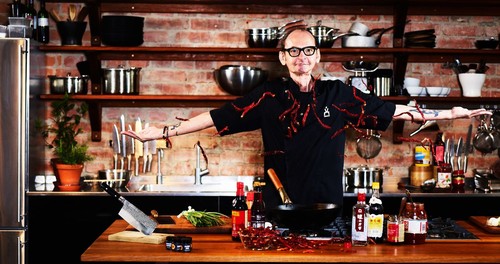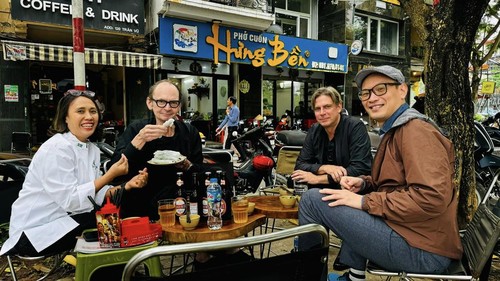 Chef Erik Videgård at a culinary event, "Taste of Sweden - Qua chieu," organized by the Embassy of Sweden in Hanoi on April 13, 2024, to mark the 55th anniversary of friendship between Sweden and Vietnam and showcase the delicious blend of Swedish and Vietnamese cuisines. (Photo credit: Embassy of Sweden in Hanoi) Chef Erik Videgård at a culinary event, "Taste of Sweden - Qua chieu," organized by the Embassy of Sweden in Hanoi on April 13, 2024, to mark the 55th anniversary of friendship between Sweden and Vietnam and showcase the delicious blend of Swedish and Vietnamese cuisines. (Photo credit: Embassy of Sweden in Hanoi) |
Bao Tram: Welcome to VOV24/7’s Cultural Rendezvous, Erik!
Erik Videgård: I’m very happy to be here. It's an honor to be in Vietnam, a country I’ve wanted for a very long time to visit.
Bao Tram: Our topic today is Swedish cuisine. What can you tell us about the Swedish food culture?
Erik Videgård: You can measure a kitchen’s style by the number of spices used. Sweden is a two-spice country – salt and pepper, that's it. Yeah, we only use salt and pepper for our traditional courses. Sweden is very much a meat and potato country from the beginning. I mean, fried or boiled meat and potatoes in different shapes – boiled, mashed, fried – but always potatoes, meat, and sauce. … Very simple, very like peasant food, I would say. Of course, now we have a lot of other things as well. I mean, we have our fish, we have our seafood. It's very nice since it's cold waters and seafood thrives very well in cold waters, so the seafood up north is really nice.
Bao Tram: From salt and pepper to seafood, I mean a sea of food, it was quite a long journey. So how do Swedish people accept new flavors?
Erik Videgård: Oh yeah, we’re really susceptible to picking up new flavors since we have so few flavors of our own. We have a really, from the beginning, very simple kitchen that makes us intrigued by other kitchens. You know, if, say, you’re a wine-producing country and you do lots of wines yourself, then you're not so interested in what other countries do. But if you don't have your own production, then you get very interested in what other countries do. The new culinary journey for the Swedish really started back in the 1950s when we began to go on short flights abroad. We started with Spain. That was the first country, and right away you could see on the menus at home paella and other Spanish dishes. Next were Italy and France, and boom, we had pizza, and we had Budapest, and we had all these other things. So, we really adapt very fast to other cultures. And then, starting in the 80s, we started to go further abroad. We went to Thailand. Now Thailand cuisine is very large in Sweden, and has been for almost 20, 30 years now.
 Erik is also one of the founders of the Swedish Sommelier Association. (Photo credit: Embassy of Sweden in Hanoi) Erik is also one of the founders of the Swedish Sommelier Association. (Photo credit: Embassy of Sweden in Hanoi) |
Bao Tram: If Swedes are receptive to new flavors from Asian countries like Thailand, how about Vietnam?
Erik Videgård: I started a restaurant in 1991 called East. At East we served food from Japan, Thailand, Korea, and Vietnam. So already in 1991 I was doing “Nem cuon”, “Nem” for the Swedish audience. I've done it a long time, but Vietnam hasn't been a tourist destination for Swedes. Swedes go to Thailand, never Vietnam, very seldom Japan. So Vietnamese food has had a slow start in Sweden.
On our first menu at this restaurant, East, we had “Nem”, the number 1 item on the menu, and “Goi cuon”, a rice paper roll with a shrimp inside, and you had “nuoc mam” to dip it in. Those were number 1 and 3 on the menu, and for some reason we changed the menu, and the whole restaurant was furious. We had to change it back. Two days later we had those items back on the menu again, because everyone loved them so much.
Bao Tram: How did Swedish diners initially react to the introduction of Vietnamese dishes?
Erik Videgård: Oh, they loved it, they loved it, they absolutely loved it because, I mean, Thai food, especially if you go to the north of Thailand, it can be very forceful, quite heavy. Vietnamese food, especially in the south, it's lighter, fruitier, more herbaceous, fresher. It's a very appealing cuisine and very appealing to women, since it's light and fresh.
 Chef Erik Videgård explores the culinary scene of Hanoi by trying Vietnamese traditional Pho Cuon. (Photo credit: Embassy of Sweden in Hanoi) Chef Erik Videgård explores the culinary scene of Hanoi by trying Vietnamese traditional Pho Cuon. (Photo credit: Embassy of Sweden in Hanoi) |
Bao Tram: Are there any particular Vietnamese ingredients or flavors that have influenced your cooking style?
Erik Videgård: Fish sauce. Of course, I love fish sauce, I only use Red Boat fish sauce at home from Phu Quoc. That's a favorite ingredient really. I use it in my meatballs even, the Swedish meat balls. I use fish sauce instead of salt. You also have the fermented shrimp paste, which you put in soups to give it a mommy wow. That's a flavor bomb. I love it. The trick is it shouldn't be overpowering, it should raise the other flavors of the dish. I mean, you have a small dollop of shrimp paste on top of a bowl of soup, but then you mix it with the soup and the soup becomes alive almost, I would say.
Bao Tram: If you had a friend who wanted to become a chef, what advice would you give him?
Erik Videgård: Well, I would say, be open. Let your mind be open to new things. Don't say, oh, I don't like that, or, ah, I would never eat that. Be open-minded. That's the main suggestion I would give. Be open. Yeah. Very nice.
Bao Tram: Thank you, Erik Videgård, for giving VOV24/7 this interview. We now know more about Swedish food culture and the influence of foreign cuisine on Swedish cuisine. Thank you again.
Erik Videgård: Thank you. It was my pleasure.